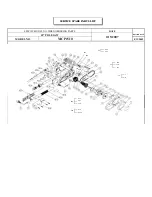
EN
10
Fig. 11
ATTENTION: Never hold the pieces to be cut in
your hand.
When the pieces to be cut are profi led sections, fl at pieces or
special shapes, refer to the examples shown in the fi gures.
If the thickness of the profi led section is to be very thin, an
outline should be fi tted which copies the profi le inside the
profi led section itself to stop it being crushed between the
jaws.
4.3
REPLACING THE BLADE (Fig. 9)
CAUTION: When you perform this operation,
always wear protective gloves to avoid contact
with the teeth of the blade.
- check that the main switch
D (Fig. 7)
is at position
0
;
- slacken the handles
Q
and slide the blades guide
P
as far
as it will go, following the direction on the arrow
(Fig. 8)
;
- remove the protective casing unscrewing the four
screws;
- slacken the blade tension, turning the handwheel
E
in a
anti-clockwise direction
(Fig. 4)
;
- extract the blade fi rst from the guides and then from the
rubber coated pulleys;
- insert the new blade fi rst between the guides and then
onto the rubber coated pulleys,
with the teeth facing as
showed in (Fig. 9)
;
- put the blade under tension again as described in point
3.1.
- replace the protective casing;
- reposition the blade guides
P
in the correct position for the
next cut.
4.4
CUTTING CAPACITY (Fig.10)
The table below specifi es the cutting capacity at 0, 45
degrees which may be obtained in normal conditions of use
described in this manual and without placing any other object
between the jaws of the clamp.
0° = Ø 152 mm; 150 mm; 205 x 150 mm
45° = Ø 106 mm; 102 mm; 105 x 95 mm
4.5
CORRECT POSITIONING OF THE PIECE IN THE
CLAMP (Fig. 11)
The pieces to be cut should be fi tted directly between the
jaws without adding other objects.
4 USE
4.1
RUNNING IN THE BLADE
ATTENTION: If the correct running in procedure
is not performed, the bladès cutting precision
may be irreparably compromised.
To obtain the best performance, the bi-metal blades fi tted on
your sawing machine must be run in for a short period.
For this reason the fi rst two or three cuts should be done
where possible on a solid piece Ø 40-50 mm, using a very
slight pressure on the blade, and gradually increasing
pressure in subsequent cuts.
To gauge the correct pressure in normal operating conditions
defi ned by this manual (see cutting table), consider for
example that the fi rst cut on solid steel (eg. C40) Ø 50 mm
should be done in about 4 minutes.
After running-in, the same piece may easily be cut in about
2 minutes. If the running-in process is done correctly, the
fi nish and precision of the cut will be of better quality and
the blade will last longer.
4.2
WORKING (Fig. 7)
Turn the main switch
D
to position
1
: in doing the switch
comes on and the machine is ready for operation.
ATTENTION: Before starting any cutting
operation, check that all the protections are
complete and in the correct position.
Once you have completed all the procedures and operations
described so far, you may start the working processes.
To perform the cut, move to the front of the machine and grip
the handgrip with your right hand.
ATTENTION: Keep your left hand away from the
cutting area and on no account try to reach it
when cutting is in process.
Use your right-hand forefi nger to press start button
A (Fig. 4)
and lower the body gradually until the blade lightly touches
the work piece to be cut.
Now begin to apply gradual pressure on the part and
complete the cut.
ATTENTION: Always release button A between
one cutting operation and another, while you are
positioning the part. do not try to block it or alter
its functional characteristics in any way.
If the machine suddenly stops after numerous
consecutive cuts, do not be alarmed. The heat protector
device of the motor has been activated, breaking the
power supply when the temperature of the coils reaches
the threshold limit defi ned by the insulation class, to
prevent damage to the motor.
In this case, release the button A and wait for automatic
reset which usually takes place after a few minutes.













































